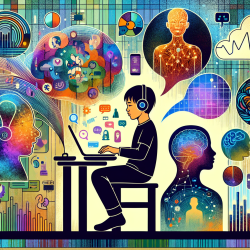Introduction
In the digital age, the intersection of solitude and technology is becoming increasingly significant, especially among adolescents. The study titled "Alone with my phone? Examining beliefs about solitude and technology use in adolescence" provides valuable insights into how technology impacts adolescents' perceptions of solitude and their emotional responses. As practitioners, understanding these dynamics can enhance our ability to support adolescents effectively.
Key Findings from the Research
The study involved 437 adolescents who were asked to imagine themselves in various solitary scenarios, ranging from pure solitude to different levels of virtual social engagement. The findings revealed that:
- Adolescents felt less alone with increased virtual engagement.
- Higher levels of virtual engagement were associated with reduced feelings of loneliness, boredom, and sadness, and increased feelings of social connection and contentment.
- The effects of virtual engagement were moderated by individual motivations for solitude, such as shyness and affinity for aloneness.
Implications for Practitioners
These findings underscore the importance of considering both the nature of adolescents' technology use and their motivations for solitude when assessing their well-being. Practitioners can implement these insights by:
- Recognizing that technology can provide a sense of connection and reduce negative emotions, especially for shy adolescents.
- Encouraging balanced technology use that aligns with the individual's comfort level and social needs.
- Using technology as a tool to facilitate social interaction in a controlled and supportive manner.
Encouraging Further Research
While the study provides a foundational understanding, further research is needed to explore the nuances of how different types of technology use impact adolescents' experiences of solitude. Practitioners are encouraged to stay informed about ongoing research and consider participating in studies that investigate these dynamics further.
Conclusion
Understanding the interplay between solitude, technology, and emotional well-being in adolescents is crucial for practitioners aiming to improve therapy outcomes. By leveraging data-driven insights and fostering environments that support healthy technology use, we can enhance the well-being of the adolescents we serve.
To read the original research paper, please follow this link: Alone with my phone? Examining beliefs about solitude and technology use in adolescence.










